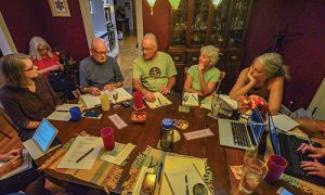
Excerpted from the Winter 2018 edition of Communities, “The Culture of Intentional Community”—full issue available for download (by voluntary donation) here.
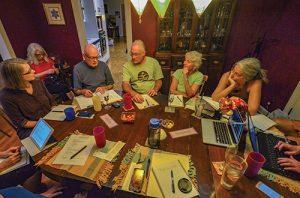
Finding the Right Path
At their monthly community meeting, Mountain Laurel Cohousing wishes to make a consensus decision about what kind of central path to build in their community. The path will connect parking areas with the homes and the common house, and will be the last major infrastructure project to be completed in the neighborhood.
To begin the meeting, the Building and Planning Committee presents information on different possible materials for the path, along with various bids provided by local contractors. Then the facilitator asks for questions and reactions from the group.
“Could you explain the different types of gravel and how much they cost?” asks Fred.
“Gravel is really difficult for wheelchairs, and some people can’t walk well on it,” says Barney. “Asphalt is a simple solution and will last for a long time.”
“I like what we currently have—a plain dirt path,” says Wilma. “We’d save money if we stick with what we’ve got.”
“Right now the path gets muddy when it rains,” says Pete, “and I’m tired of tracking mud into the house. We need to make a decision and get this built as soon as possible.”
“Does this expense fit into our construction budget,” asks Luisa, “or our annual budget?”
Betty raises her hand. “I’m strongly opposed to asphalt. I think we need a more environmentally-friendly solution.”
“Why are the estimates on labor so high with one contractor and so low with the other?” asks Felicity.
“I’m not sure we can trust that contractor who lives down the road, I’ve heard some bad things about him,” adds Sam.
“Why didn’t any of the proposals suggest permeable pavement as a solution?” asks Martha.
In this brief go-round, community members raised questions of content and questions of value, and some members also began advocating for particular outcomes. Community values like Affordability, Sustainability, and Accessibility are in the mix, alongside technical and factual questions about budget, path materials, and trustworthiness of contractors.
From this point in the discussion, how can the community proceed toward a consensus decision? What collaborative skills are essential for the group to have an efficient and productive decision-making experience that leads to positive, tangible results for the community?
Physical Infrastructure and Cultural Infrastructure
In the story above, Mountain Laurel Cohousing (MLC) is attempting to make a decision on an element of the community’s physical infrastructure. Because they are a community who has chosen to govern themselves using collaborative processes (like consensus or sociocracy), they must rely on their cooperative skills and their interpersonal bonds in order to reach a good solution. In other words, they must rely on what I call their “Cultural Infrastructure” to make a good decision about their Physical Infrastructure.
Across my experiences in planning two intentional communities, living in one, and working as a facilitator and consultant for many more, I’ve noticed that forming communities often put the most time, energy, and attention into the Physical Infrastructure of the community—the land, the homes, the common house, the roads, and other shared infrastructure. This makes a lot of sense, right? Most communitarians are hoping for a great place to live and wonderful resources to share, and it’s a big challenge to finance and build all of this, so of course it deserves a lot of attention.
However, I believe that Cultural Infrastructure—shared values, governance system, social connections, leadership framework, conflict tools, power distribution, communication styles, community bonds—is just as important, though often neglected. Every human group has a Cultural Infrastructure, though we may not be consciously aware of what it is or how it functions, especially when we are members of the mainstream or dominant groups in a society or institution. (For example, as a white male in the United States, I can be blind to how this culture tends to welcome people like me into leadership positions while excluding women and people of color.)
Many of us seek community for the quality of human connections as well as the opportunity to create collaborative and sustainable models of human life. We want to create healthy, just, and sustainable communities that provide alternatives to cultures based on domination and exploitation. In order to succeed, we all need to develop competent-to-great skills in communication and collaboration. And yet, in spite of our idealism, many of us are working at a skill deficit in these areas simply because we’ve been raised in competitive, hierarchical, and aggressive cultures and institutions. While we can hire green builders to construct our sustainable homes, we ourselves are ultimately responsible for the quality of our community relationships and the depth of cooperation we achieve in collaborative groups.
That’s why I advocate that communities spend much more time and energy on cultivating collaborative skills and building a strong and cooperative “Cultural Infrastructure.”
So, what helps us shift from a Culture of Competition to a Culture of Collaboration? Communities need a clear, cooperative decision-making process, a commitment to address conflict, and ongoing support for members in developing collaborative skills.
Having a Clear, Staged Decision-Making Process
First order of business: having a clear decision-making process and the group discipline to follow it. In a collaborative decision-making process, whether consensus or sociocracy, it’s essential to have clear steps for moving towards proposals and decisions. In the MLC example, the discussion is chaotic in part because people are attempting to do multiple tasks simultaneously: ask factual questions, express personal feelings, explore the meaning of community values, and advocate for specific solutions. All of these actions are valid, but they cannot be handled productively at the same time. It’s important to separate these tasks and address them one step at a time. Planning the focus of each conversation is the job of the agenda setters and the facilitators, but each member of the group should have awareness of where the group is in the larger process and the self-discipline to offer only what is needed in the current stage of the conversation.
One of the common pitfalls in cooperative groups is starting the discussion with a proposal. Instead of beginning with the proposal (unless there is an urgent or emergency situation), collaborative groups must first take time to introduce the problem and the topic, address questions of clarification, clear the air of emotional charge as well as they can, identify underlying concerns and values, and then together create a set of criteria and factors that can guide proposal-formation. Once that set of factors for guiding proposals has been created, then the whole group may empower an ad hoc group or a subcommittee to craft a proposal using the criteria established and approved by the larger group. A good proposal will balance the criteria, honor the parameters, and address the concerns raised by the group.
One good model is the Six-Step Consensus Process Model that Laird Schaub has developed:
Initial presentation of the issue
Questions
a. Clear the Air
Discussion
a. Brainstorming criteria
b. Values connection
c. Prioritizing
Proposal Forming
Decision
Implementation details
There are many nuances here that deserve more detailed discussion than I have time for in this essay. Whatever model your group adopts, be mindful that it is crucial to have a well-structured decision-making process that does not begin with proposals, and further that group members are conscious of where they are in the process at each step along the way so that they can contribute effectively and productively to a strong community decision.
Conflict Tools
After living in a cohousing community for a few years, I felt a need to develop my own skills in collaborative governance, and I began a two-year training program in facilitation. One of the main insights I learned from that facilitation training—which included visiting and working with several intentional communities around the Southeast—was how essential it is for communities to have agreements and tools for working on conflict and addressing emotional energy.
My home community had no such agreements, so I set to work with our facilitation team to shepherd a discussion on this issue at one of our monthly community meetings. Given the amount of tension and conflict that we had already experienced in a few short years, I expected that my neighbors would see the importance of having conflict resolution policies, and that we could begin crafting a proposal to adopt tools to help us navigate conflict and emotional energy during meetings and in our daily life together. However, after the facilitation team introduced the topic, the conversation immediately stalled when one of the founders of the community voiced strong opposition.
“Our monthly meetings are business meetings, not therapy sessions,” he argued. “We’re not here to work on people’s emotional issues. Emotions shouldn’t be brought into a business meeting.”
This founder had expertise in construction and development and he had played a crucial role in building the community. Because of his status, his words were powerful enough to stop forward movement on creating formal agreements around working conflict in our community. In my remaining four years of living there, the best we achieved around a conflict policy was a set of suggested steps and resources that people might use informally if they wanted. However, the facilitators never received community permission to work on a conflict or address emotional charge during community meetings.
The words of the founder who spoke out against having a conflict policy held at least a few layers of irony. First, any gathering of human beings, even one categorized as a “business meeting,” is going to involve human emotions and at least occasional conflict. Smart organizations, including mainstream businesses, have detailed conflict resolution policies and tools in place. For intentional communities, it is an established best practice to have clear conflict agreements and tools that are regularly practiced in and out of group meetings. So, even though this founder spoke with an air of authority, he was poorly informed about the role of emotion and conflict in human groups, and the importance of conflict agreements and tools for a healthy organizational culture.
The second layer of irony was that he himself often brought a high level of emotional charge into business meetings. While he was known and respected for his calm and logical demeanor, his energy shifted when the group was discussing controversial issues that he cared about, and he could quickly become impatient, sarcastic, and even volatile if people did not agree with him. In addition, during meetings his partner was prone to emotional outbursts that were very impactful and often left the facilitators and the group at a loss on how to address what happened and how to get the meeting back on track. So the second layer of irony was a lack of self-awareness around his personal emotional volatility and his impact on the group, and how he himself could not live up to his view that there should be no emotional expression during a business meeting.
Self-awareness and emotional awareness are essential capacities and skills for members of collaborative groups, as are skills in recognizing and empathizing with the feelings and needs of others. There will be feelings in community business meetings, and we can all develop our abilities to navigate complex discussions amidst the rising and falling tides of emotion within us and around us.
When emotion reaches a certain level of intensity, people may stop listening to one another and the group’s ability to proceed effectively diminishes. That’s why it’s important to have a Conflict Tool in place and agreements for how and when to use it that include permission for facilitators to offer the tool during community meetings. At my current community-in-formation, Hart’s Mill Ecovillage, we have developed a Five-Step Conflict Tool that is a hybrid of NVC/Compassionate Communication and Laird Schaub’s Four-Step Conflict Tool:
What happened?
What feelings do you have about it?
What’s at stake for you? What needs do you have that were not met in this situation?
What are you willing to do to help solve the problem or improve the situation?
What would you like others to do?
The standard use of this tool is to work with two parties in conflict, and create a safe space for each person to share their perspective. At each step, one person speaks and then the other offers reflective listening; then the roles are reversed. We move onto the next step only when each party feels fully and accurately heard. This tool deserves more discussion than I have room for here. But notice how the effective use of the tool requires the capacity to speak one’s own experience, feelings, and needs; listen accurately to the other person and recognize their feelings and needs; and make commitments and requests to improve the situation.
Having an effective conflict resolution tool and a culture of practice is vital for healthy collaborative groups. There are good Conflict Resolution tools and frameworks out there. Find and adopt one for your community. And practice, practice, practice.
Collaborative Skills and Communication: Strategic Communication vs. Communication Oriented towards Reaching Understanding (COTRU)
To get a better sense of the variety of collaborative skills that communities need to work on, it helps to understand the different forms of communication we employ in our cooperative work together. In his work on Communicative Action, the philosopher Jürgen Habermas distinguished between two different approaches to communication. The first approach, Strategic Communication, is prominent in competitive cultures, and aims to “win” the conversation and persuade others to work for our personal goals. By contrast, Communication Oriented towards Reaching Understanding (what I like to call COTRU, or “co-true” for short) seeks to include all voices and perspectives, deepen mutual understanding, foster shared values, and achieve common goals.
Within COTRU, Habermas identifies three types of Speech Acts: Descriptive, Normative, and Expressive [see Figure 2].
In a Descriptive speech act, the speaker is making truth-claims about the objective world; for example, “Asphalt is more expensive than gravel.” Whether or not the group accepts this claim as true is a matter of evidence, verification, and discussion. Remember here that all truth-claims and fact-claims are contestable; “facts” and “truth” must be established and agreed upon within a community of understanding.
For Normative speech acts, the speaker is making value-claims about the social and ethical world; for example, “Sustainability is important in this community, and asphalt is not sustainable.” The legitimacy and meaning of such claims will need to be assessed by the members of the community based on their shared values and agreements. Remember that groups should expect diverse interpretations of their values and agreements—even carefully and clearly written ones will still be open to multiple interpretations. Note too that values (and people) are dynamic—there are no fixed or final definitions that can eliminate questioning, debate, or conflict over the meaning of shared values.
With Expressive speech acts, the speaker is making claims about their inner, subjective world; for example, “Accessibility is important to me, and I feel sad when I imagine a path in our community that is not wheelchair-accessible.” Whether or not this statement is valid is a matter of honesty, sincerity, and authenticity on the part of the speaker. Remember here that when people show up as their full and complex selves, our relationships and our communities become richer, so we want to create safe spaces for people to share all of who they are. Note too that there is important information in emotions, but that our personal emotional and psychological states also flow and shift—sometimes rapidly.
Each of these three types of speech acts—Descriptive, Normative, and Expressive—are relevant to the MLC path conversation, and to any decision process in cooperative communities. The three types of speech acts invoke three general standards for guiding the community—Truth, Goodness, and Authenticity—and are connected to three corresponding questions that guide collaborative conversations: “What’s happening and what are the facts?,” “What are the shared values?,” and “What does everyone think and feel?” Cooperative decision-making is based in having access to the best information, being clear about group values, and including all voices and each member’s full self in the conversation.
Collaborative Skills and How to Cultivate Them
Reflecting on the MLC conversation, the Consensus Decision-Making Process, the Conflict Tool, and the COTRU Speech Acts discussed above, we can begin to identify a set of collaborative skills that will help community members work together more effectively to achieve their goals within a Culture of Cooperation:
Self-awareness: Listening to Self
Emotional Intelligence: Recognizing feelings and identifying needs
Personal Expression: Speaking for Self
Listening Accurately to Others
Empathizing with Others
Equity and Justice: Commitment to meet everyone’s needs as much as possible
Research: Finding the relevant facts, examples, and knowledge to guide us
Observation: Clear and accurate perception of what’s happening
Verification: Testing truth claims, evaluating arguments and evidence
Creativity: Using Imagination to open new possibilities
Comfort with Uncertainty and Paradox
Sense of the Common Good: Serving the well-being of the whole
Deciding Together using shared group values and agreements
Commitment to Growth, Learning, Healing
Openness to receiving Feedback and working with it
This list is not meant to be comprehensive—it highlights several key skills, and it continues to evolve through my own community experience and my work as a facilitator. Also, it’s important to remember that very few of these skills and capacities are valued in the dominant organizational cultures in the United States. Hence most of us have a skill deficit in several of these areas regardless of our personal ideals or dedication to community and collaboration. The good news is that each of these skills can be learned, developed, and polished through commitment and practice. To close, I’ll offer a handful of suggestions for how to cultivate these skills.
First, groups can make time in community gatherings and meetings to practice skills. For example, a quick opening go-round to start a meeting could ask everyone to “identify one to three feelings that you are experiencing today.” When I do this opening, I like to give people a list of feelings, since many of us do not have well-developed emotional vocabularies. You can do the same quick opening go-round with “identifying one to three needs that you connect to community.” Again, I would provide people with a list of needs in order to help build their vocabulary and awareness. The Center for Nonviolent Communication offers very helpful PDF documents for both a Feelings Inventory and a Needs Inventory at their website: www.cnvc.org.
In order to build awareness during collaborative discussions, identify which of the three Speech Acts the group is focusing on in the moment, and create activities to solicit that kind of input from group members. For example:
Descriptive: “Right now, let’s focus on getting the facts about the situation and collecting questions of clarification.”
Normative: “Let’s brainstorm to list the relevant community principles and values that can guide any decisions we might make on this topic, and see if we have questions about what these values mean and how they apply.”
Expressive: “We’ll now begin a sharing circle to hear each person’s feelings and thoughts on the issue.”
Take time out for moments of silence and invite people to check in with themselves, paying attention to what they are feeling and needing, and what they want to contribute to the conversation that hasn’t already been said.
Include Pair and Small Group Activities in large meetings in order to provide structure for each person to share and to listen carefully to others.
Practice Reflective Listening during meetings. My wife María has a great habit of gently asking people to stop and reflect back what she (or others) just said in meetings before moving on. “Pete, what did you hear me say just now?” This way, she can be confident as a participant that people are hearing and understanding her perspective before rushing to express their own views and losing her comments in the shuffle.
Ask people to contribute to group discussions based on the standard of “What does the group need to hear from me right now?” instead of “What do I want to say?”
When checking for objections, consent, and/or consensus, remind people that we decide together based on group values, not on personal preferences.
Use group time to practice your Conflict Tools with Role Plays. It’s essential that group members practice the tool before they need to use it when the emotional stakes are high.
Create a safe and respectful environment for giving and receiving feedback. End meetings with evaluations of what went well and what could be improved. Provide regular forums for leaders to receive feedback. Recognize that we all have a lot to learn.
Commit to growth and healing. Find support inside and outside of community to heal the wounds we’ve suffered in aggressive and hierarchical cultures.
Finally, encourage members to make time on their own to practice skills in their daily lives—family, work, and relationships provide ample opportunities to practice!
These are just a few suggestions for building skills and cultivating awareness as you create a Culture of Collaboration in your community. Clarify your cooperative decision-making process, adopt conflict tools, and commit to the ongoing development of collaborative skills in your group.
Excerpted from the Winter 2018 edition of Communities, “The Culture of Intentional Community”—full issue available for download (by voluntary donation) here.
Go to the GEO front page

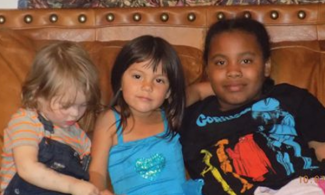

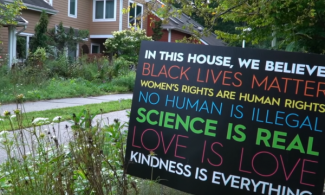
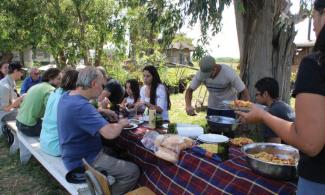
Add new comment